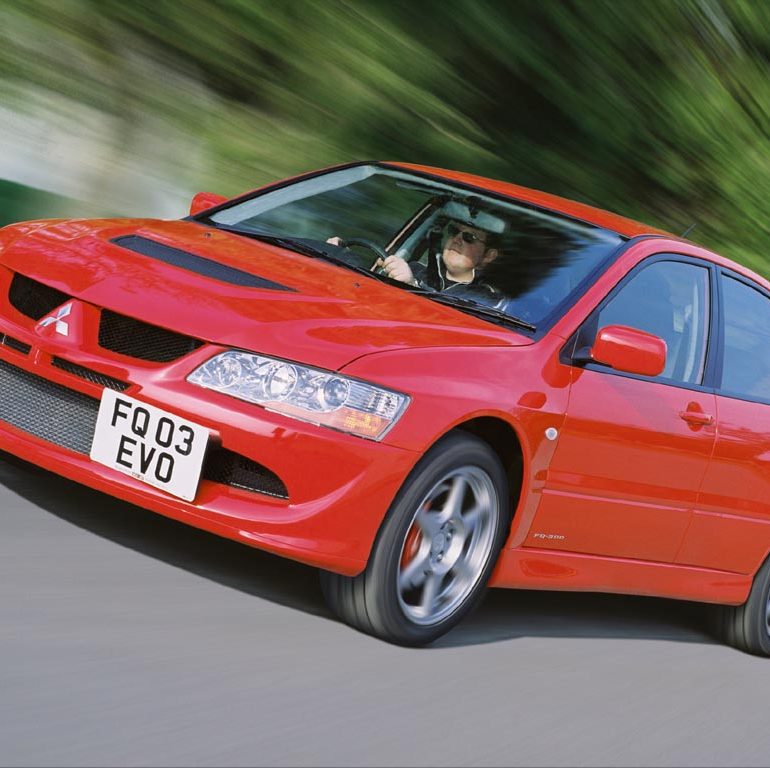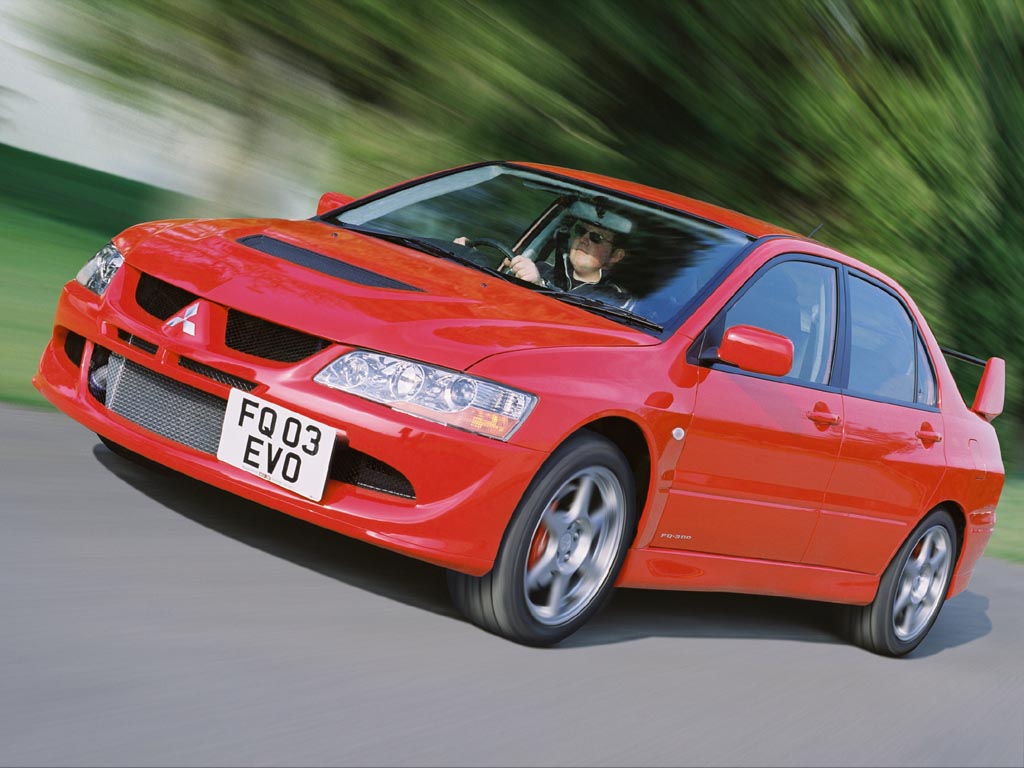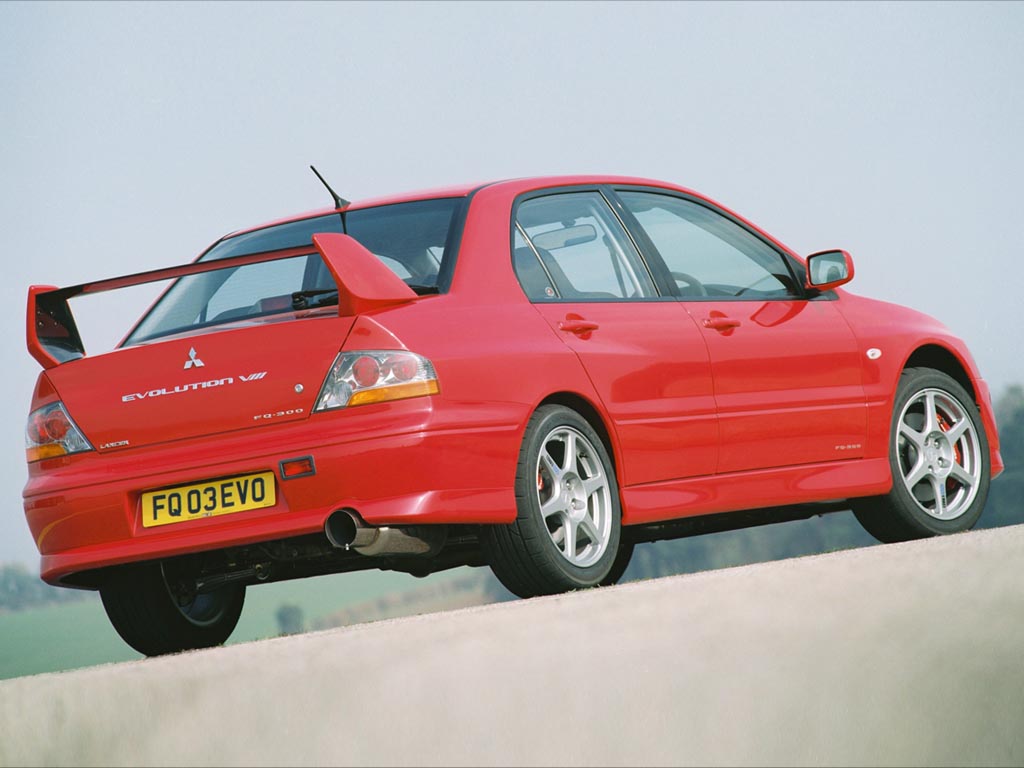2003 Mitsubishi Lancer Evolution VIII FQ-300
Universally acclaimed for its raw power, exceptional handling and an emotionally spine-tingling driving experience, the new generation Mitsubishi Lancer Evolution VIII is about to hit the streets of Europe. In the last few months, Mitsubishi’s motorsport and performance car division, Ralliart, has been moved in-house. Now part of the Mitsubishi Motors Corporation and Mitsubishi Motors Europe operation, Ralliart is to become a premium sub-brand.
Mitsubishi Motors in the UK is the sole importer and supplier of official Ralliart products and accessories.
Available in two specifications and with a top speed of 157mph, power output for the new Evo VIII is 276bhp as standard. However, for those customers who like a little more under the bonnet the FQ-300 performance package, developed in conjunction with the Mitsubishi World Rally Team, boosts power to in excess of 300bhp.
The Mitsubishi Evolution series is all about continuous enhancement using performance technology and the new Evo VIII delivers on all counts. Improvements on its predecessor include the addition of Super AYC (Active Yaw Control) and a 6-speed close ratio gearbox; extensive improvements to and tuning of the engine, suspension and aerodynamics; a stiffer body and extensive reductions in weight. The result – the new Lancer Evolution VIII reaches new dimensions of on-road performance and driving exhilaration.
Under the bonnet
Beneath the Evo VIII’s bonnet is Mitsubishi’s latest version of the high-performance 4G63 2.0-litre intercooled turbocharged 4 cylinder, DOHC 16-valve engine that boasts unmatched levels of maturity and refinement. Producing 276 bhp in standard tune at 6,500rpm, whilst delivering a class-topping 289 lb ft of torque at 3,500rpm. By adopting a 6-speed close ratio gearbox, maximum response from the engine and transmission is retained throughout the broad powerband.
For the Evo VIII, Mitsubishi has further developed its famous 4G63 type 2.0-litre engine by redesigning the turbocharger, increasing the capacity of the intercooler and redesigning the intake manifold to reduce air-flow resistance by 20%. A 3-nozzle intercooler jet system sprays water on to the front of the intercooler which helps cool the compressed air going through the intercooler providing more power under hard acceleration.
Engine durability and reliability have also been improved by up-rating the aluminium pistons and forged steel con rods. These detail improvements result in an engine that combines competition-ready but street-friendly power with outstanding durability.
The exhaust pipe has been straight-lined to reduce exhaust back pressure and a variable back pressure valve has been added to the main silencer to improve quietness at low engine speeds. The combined fuel consumption figure for the Evo VIII is 20.5 mpg and CO2 is 334 g/km. Top speed is restricted to 157 mph and the official factory 0-62mph time has been given as a ‘conservative’ 5.3 seconds.
The FQ-300 performance package statistics have yet to be officially confirmed, but early indications point to power in excess of 300bhp, an equally impressive torque exceeding 300lb.ft. and a 0-62 time of 4.9 seconds.
Mitsubishi’s advanced 4WD system
The Lancer Evolution VIII has a revised suspension system, slightly lower slung to get the centre of gravity lower. A revised ACD (Active Centre Differential) and rear limited slip differential are used in conjunction with the new Super AYC (Active Yaw Control).
Debuting on Evo VIII, the new Super AYC realises significant performance improvements. After carefully calculating torque requirements under simulated race conditions, Super AYC has been developed to transfer twice the torque of the current AYC. The ability to transfer more torque between the rear wheels further reduces understeer while extending cornering limits (in-house skid-pad testing has shown that Super AYC extends Evo VIII’s cornering limit by 10% over the current system).
Super AYC also acts like a limited slip differential by increasing inside wheel traction in race circuit and other high speed cornering situations, thereby preventing the wheel slip that can occur with the current system due to its smaller torque transfer capacity.
ACD enhances acceleration and straight line stability. An electronically controlled multi-layer hydraulic clutch replaces the conventional VCU as the differential limiter, controlling front/rear drive power distribution on the centre differential and switching from free to direct-link status to maintain its front/rear drive force setting of 50:50 distribution while matching the driving conditions. This achieves a tuned balance between handling response and drive performance of the highest level.
In addition, the driver can switch between the 3-modes TARMAC, GRAVEL, or SNOW settings, while the car is moving, to optimise control and to match road conditions.
A computer controls the new active centre differential (ACD) and super active yaw control (AYC) systems with the ACD maximising performance when accelerating out of a corner, and AYC supporting performance during cornering. This new integrated control system provides better overall stability and performance compared to systems that control ACD and AYC independently.
Transmission
The new generation Evo VIII is the first to be given a 6-speed manual transmission. The 6-speed close ratio gearbox has been developed in order to maximise extra torque generated by the revised 4G63 2.0-litre intercooled turbocharged 4 cylinder, DOHC 16-valve engine. The close ratio set up maximises engine performance throughout its entire range but with improved flexibility at low to medium speeds.
Outside and in
In keeping with its principles, exterior restyling has not been about simple cosmetic improvement. Reducing drag and lift, the Evo VIII’s new exterior lines give it better high-speed straight line stability and handling through corners and features significant advances in aerodynamic and cooling performance.
The new exterior incorporates the defining elements of Mitsubishi’s new design identity. A significantly restyled and more aggressive front end is distinguished by its integral grille-front bumper, the centre of which has been extended 35mm forwards, and by its V-shaped nose. The bonnet is noticeably different with the addition of a large single air intake for the intercooler. New rear light clusters, a large carbonate rear spoiler and new 17-inch alloy wheels set the new model apart from those which have gone before. Recaro seats, Momo steering wheel and fully automatic air conditioning match luxury with performance.
Story by Mitsubishi Motors Corporation UK
Story by Mitsubishi Motors Corporation UK
In Detail
| submitted by | Richard Owen |
| engine | 4G63 Inline-4 |
| aspiration | Turbocharger w/Intercooler |
| fuel feed | ECI-MULTI Electronic Fuel Injection |
| displacement | 1997 cc / 121.9 in³ |
| bore | 85 mm / 3.35 in |
| stroke | 88 mm / 3.46 in |
| power | 227.4 kw / 305 bhp @ 6200 rpm |
| specific output | 152.73 bhp per litre |
| bhp/weight | 216.31 bhp per tonne |
| torque | 406.75 nm / 300 ft lbs @ 4500 rpm |
| driven wheels | Full Time 4WD w/Active Centre Differential, Active Yaw Control, |
| front tires | 235/45ZR17 Yokohama ADVAN AO46 |
| rear tires | 235/45ZR17 Yokohama ADVAN AO46 |
| front brakes | Brembro Vented Discs w/4-Pot Calipers |
| f brake size | x 320 mm / x 12.6 in |
| rear brakes | Brembro Vented Discs w/2-Pot Calipers |
| r brake size | x 300 mm / x 11.8 in |
| front wheels | F 43.2 x 20.3 cm / 17 x 8 in |
| rear wheels | R 43.2 x 20.3 cm / 17 x 8 in |
| steering | Rack & Pinion w/Power Assist |
| f suspension | MacPherson Struts w/Inverted Shock Abosrbers, Stabiliser Bar, Lower Arms |
| r suspension | Multi-Link w/Stabaliser Bar |
| curb weight | 1410 kg / 3109 lbs |
| wheelbase | 2625 mm / 103.3 in |
| front track | 1515 mm / 59.6 in |
| rear track | 1515 mm / 59.6 in |
| length | 4490 mm / 176.8 in |
| width | 1770 mm / 69.7 in |
| height | 1450 mm / 57.1 in |
| transmission | 6-Speed Manual |
| gear ratios | 2.909:1, 1.944:1, 1.434:1, 1.100:1, 0.868:1, 0.693:1, :1 |
| final drive | 4.583 :1 |






